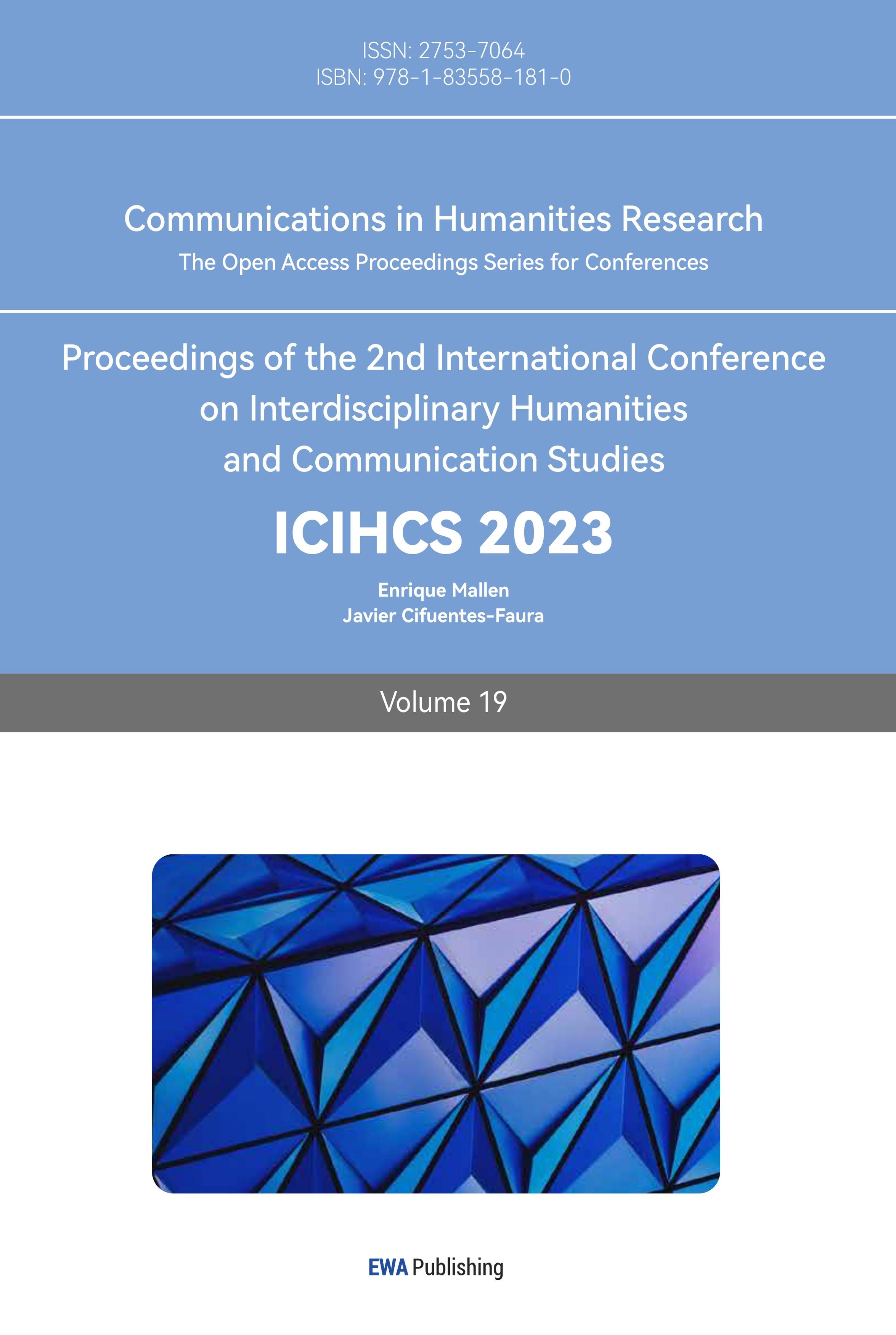1.Introduction
Chinese media and entertainment companies have increasingly tapped into the creative power of fans, fostering relationships, and embracing co-creation, which has led to innovative product development and industry growth [1]. A study found that emotions can significantly influence customer behavior in the fan economy, as demonstrated by a game model that incorporates emotional function and evolutionary game analysis [2]. Some researchers also developed theoretical models to examine excessive consumption and identification, shedding light on the positive and negative outcomes of intense fan identification and understanding the complexities of mediated development and audience reception [3]. Additionally, a study explored the impact of social media influencers on consumers’ willingness to purchase products through live streaming, particularly with the surge in popularity of live streaming during and after the pandemic [4].
Moreover, in-depth analyses of virtual idols in the new era revealed how virtual idols capture global attention and cultivate a dedicated fanbase through captivating performances and interactive experiences. Virtual idols fulfill people’s needs for singing, dancing, and enhancing daily life experiences [5]. One notable phenomenon is the virtual idol Hatsune Miku, which revealed a unique opportunity to showcase the power of social media in inspiring real-life action [6]. Researchers examined the Hatsune Miku phenomenon as a case study of Generated Media and Generated Content in Japan, focusing on the diffusion process, interaction mechanisms, and the network effect associated with her [7].
Regarding TikTok/Douyin, some studies investigated the performance of relevant topics on these platforms. The results demonstrated that TikTok’s community attributes and interactive engagement enhance perceived value, driving continued platform use and creative behavior [8]. Motivation, timing, personal characteristics, and entertainment aspects were identified as influential factors in the behavior of TikTok users. The impact of viral marketing, promotion, and flash sale variables on purchase intentions in the TikTok shop marketplace was also examined [9]. Researchers further explored the influence of social media and viral marketing on purchase decisions through TikTok apps, showing that both factors significantly impact purchase decisions based on multiple linear regression analysis of a sample of 190 respondents [10].
Generation Z, born between 1995 and 2009, has been greatly influenced by various technologies such as instant messaging devices, smartphones, and tablet computers. In China, Generation Z comprises 275 million active users dependent on the Internet due to their exposure to Internet technology from a young age. Furthermore, researchers analyzed the influence of different types of endorsers (traditional celebrities, micro-celebrities, and virtual influencers) and their source credibility on the purchase intentions of Chinese Generation Z consumers. The findings highlighted the relevance of attachment theory in social media endorsement advertisements, providing insights for marketers targeting Generation Z [11].
In the digital age, users gravitate towards short videos, and both virtual and human idols utilize short video platforms to facilitate product consumption and gauge user preferences for purchasing. Advanced algorithms enable personalized content delivery, catering to virtual or human idol fans. However, there needs to be more specific research comparing the purchasing preferences for human and virtual idol fans on TikTok of a particular age group (such as Gen Z). This paper distributes a consumer behavior inclination questionnaire to fan groups of human idols and virtual idols on the TikTok platform. By analyzing the survey data, this paper draws various conclusions regarding user stickiness, idol content identification, purchasing power, and the types of products purchased, highlighting the differences between the two groups. The findings of this paper offer insights for companies seeking to promote idol-related products on social media platforms like TikTok, enabling them to understand and effectively engage with the consumption behavior of Generation Z about both human and virtual idols.
This paper primarily focuses on the purchasing preferences of Chinese Generation Z fans for human and virtual idols on TikTok, providing substantial implications for marketing strategies and fan engagement. The paper’s findings highlight four key conclusions: Firstly, fans of human idols and virtual idols exhibit distinct purchasing preferences. Human idol fans prefer practical items, while virtual idol fans show greater interest in limited collections and online/offline experiences. Secondly, virtual idol fans demonstrate higher user engagement and emotional connection than human idol fans. Thirdly, virtual idol fans tend to be more irrational in buying decisions and possess greater purchasing power with idol-related merchandise. Lastly, effectively targeting these two groups requires employing different marketing strategies. The paper provides a comprehensive overview of the research methodology, experimental results, data analysis, and their implications for marketing strategies and fan engagement.
2.Method
The paper conducts a comprehensive consumer behavior inclination questionnaire among fans of human and virtual idols who were also active TikTok users. The questionnaire contains four parts, including categorizing respondents, TikTok usage behavior, idol consumption behavior, and self-assessment of income and expenditure. This paper focuses on fans’ content participation and output on social media, purchasing behavior, and how human or virtual idols promote fans’ consumption through TikTok. This paper conducts specific experimental studies that compare fan groups in Generation Z, in terms of purchasing products, participating in online/offline activities, and marketing preferences between human and virtual idols.
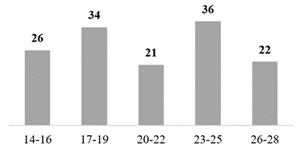
Figure 1: Age group distribution.
To compare the consumption behavior of two fan groups, 160 completed questionnaires are collected from fan groups living in 61 cities and with different educational backgrounds. Among all questionaries, 139 are valid for the analysis (Active TikTok Users). The male-to-female ratio is 3:7, and there is not much difference between the fan groups of human and virtual idols (54% and 46%, respectively). On average, each respondent takes 3 minutes to complete. The paper compares the two groups in several areas, including TikTok APP usage, video content preference, fan engagement, consumption preference, and purchasing power.
Additionally, this paper investigates how different types of content trigger business conversion among fans. The paper provides insights into the consumption behavior of Generation Z and offers practical recommendations for companies promoting idols on social media platforms. The age range of respondents is generally between 17-19 and 23-25 (Figure 1), which is related to the higher distribution of high school and undergraduate education, which two categories account for 67% of total respondents (Figure 2).
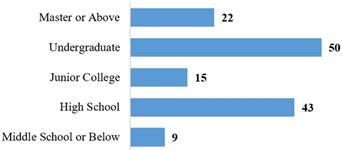
Figure 2: Education level distribution.
3.Experiment Results and Analysis
3.1.Data Retention and Preprocessing
A total of 160 questionnaires were collected, and after excluding non-TikTok users and inactive TikTok users, the final number of valid questionnaires is 139. In addition to removing invalid questionnaires, the following data preprocessing operations are conducted: 1. Calculating age groups based on the respondents’ selected year of birth. 2. Assigning values to the frequency of idol consumption per month (Table 1). 3. Estimating the monthly expenditure on idol-related consumption based on the options selected (Table 2). 4. Estimating income by taking the median of the selected income range (same as the estimation for product purchase). 5. Reorganizing the 15 specific consumption product categories into the following seven categories: Practical Peripherals, Online Experience, Offline Events, Music, Film and TV Shows, Limited Collection, Idol Support, and Clothes and Accessories. 6. Assigning values to TikTok idol-related behaviors based on the frequency selected by the respondents and the complexity of the behaviors (Table 3). Furthermore, if a certain option is chosen as the most frequent in a ranking question, it is given double points, and the second option is given 1.5 times the score.
Table 1: Frequency of idol-related product consumption options and scores.
Frequency of Product Consumption |
Score (per month) |
A.More than 4 times a week |
20 |
B.2-3 times a week |
10 |
C.Once a week |
4 |
D.2-3 times a week |
2.5 |
E.Once a month |
1 |
F.1-2 times per quarter |
0.5 |
G.Less than once a quarter |
0.2 |
H.Never |
0 |
Table 2: Monthly idol-related purchase estimation (RMB).
Monthly Idol-related Purchase (RMB) |
Estimation |
A. Under 100 |
50 |
B. 100-200 |
150 |
C. 201-500 |
350 |
D. 501-1000 |
750 |
E. 1001-2000 |
1500 |
F. 2001-5000 |
3500 |
G. 5000-10000 |
7500 |
H. Over 10000 |
15000 |
I. None during recent year |
0 |
Table 3: Scores for idol-related behaviors via TikTok.
Idol-related Behaviors via TikTok |
Score |
A. Comment on videos |
1 |
B. Like/Favorite videos |
0.5 |
C. Forward videos |
1.5 |
Table 3: (continued).
D. Purchase Idol-related products |
2 |
E. Interact with other fans |
3 |
F. Watch idol’s live-streaming |
3 |
G. Live Tipping in idol’s live-streaming |
6 |
H. Make idol-related videos |
10 |
3.3.Contrasting Purchasing Preferences of Gen Z Fans for Human Idols and Virtual Idols
Generation Z fans exhibit distinct purchasing preferences when it comes to human idols and virtual idols, as revealed by the data. This paper discovers that fans of virtual idols tend to exhibit a higher frequency of purchasing related products each month than fans of human idols (Figure 3). Specifically, the paper indicates that on average, human idol fans consume idol-related products merely 1.96 times per month. In contrast, virtual idol fans surpass this figure significantly, with an average of 7.05 purchases per month, indicating that they buy 2.6 times more idol-related products than their counterparts who follow human idols.
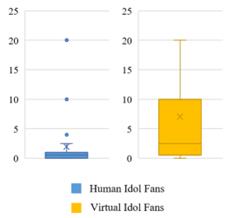
Figure 3: Monthly idol-related product consumption frequency.
When consuming idol-related products across seven categories, fans of human idols exhibit greater purchasing power for practical peripherals, whereas fans of virtual idols display a stronger inclination towards purchasing products for limited collection and online/offline experiences (Figure 4). Specifically, the category of ‘Idol Support’ encompasses purchases such as magazines, posters, standing boards, and fan light boards. ‘Offline Events’ include expenses related to fan meetings, airfare, hotel accommodation for idol events, exhibitions, concerts, anime conventions, and themed restaurant experiences. ‘Online experiences’ involve the purchase of paid emojis, navigation voice packs, music/video app memberships, games, electronic products, and live stream donations. In general, virtual idol fans tend to consume idol-related products at a significantly higher rate than fans of human idols across almost all categories except for one category (Music, Film, and TV Shows). The three categories that exhibit the greatest variance in purchasing preferences between the two groups are Offline Events, Clothes and Accessories, and Limited Collection products, with virtual idol fans surpassing human idol fans by 267%, 154%, and 148%, respectively.
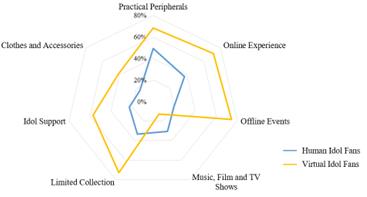
Figure 4: Idol product consumption comparison (in seven categories).
3.4.Higher User Stickiness and Emotional Connection in Virtual Idol Fans Group
The findings from the paper suggest that virtual idol fans tend to show longer-term dedication to their idols (Figure 5). Specifically, 72% of virtual idol fans have been supporting their idols for more than two years, highlighting their loyalty and enduring commitment. On the other hand, 60% of human idol fans have shown a liking for their idols for a shorter duration, less than three years, indicating a relatively shorter period of attachment. These results underscore the remarkable loyalty and emotional connection of Generation Z virtual idol fans.
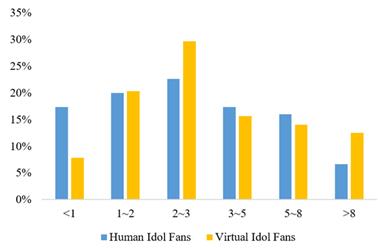
Figure 5: Years of liking the idols distribution.
Furthermore, virtual idol fans exhibit a higher level of addiction to TikTok and spend more time engaging with idol-related content and interacting with fellow fans on the platform (Table 4). A significant 58% of virtual idol fans use the TikTok app for more than four hours per day (53% of human idol fans use the app for less than 2 hours per day), highlighting their strong loyalty to the platform. The usage duration reveals an opportunity to capture their attention and purchasing, particularly since 54% of their TikTok time is devoted to watching idol-related content. Additionally, virtual idol fans demonstrate a 59% higher score in terms of idol-related behaviors on TikTok compared to fans of human idols, indicating a greater level of user engagement and stickiness. Short video influencers can leverage and monetize the attention resources of virtual idol fans by collaborating with advertisers.
Table 4: TikTok usage (weighted mean) comparison of two groups.
Groups |
TikTok App Daily Usage (hours) |
Watching Idol-related Contents (% of duration) |
Scores for Idol-related Behaviors via TikTok |
Human Idol Fans |
1.9 |
49% |
6.1 |
Virtual Idol Fans |
3.5 |
54% |
9.7 |
Variance |
84% |
11% |
59% |
Due to TikTok’s accurate content algorithm, fans are more likely to watch their favorite content and strengthen their identity as fans, which in turn boosts their buying power. The growing popularity of idol-related topics has resulted in increased fan engagement, including actions such as liking, commenting, and sharing the content. As the fan economy expands and fans’ purchasing influence becomes more recognized, the concept of idol chasing has evolved, placing greater emphasis on idols as commodities. Consequently, virtual idol fans, who spend more time watching idol-related videos, tend to have higher monthly consumption of idol-related products (Figure 6). Additionally, fans’ willingness to make purchases has continued to rise, with 41% of virtual idol fans expressing a desire to consume more, compared to only 16% among fans of human idols. This highlights the significant impact of virtual idols on fan consumption behavior and their increased desire for idol-related products.
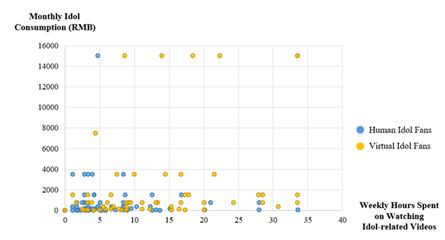
Figure 6: Consumption and duration of watching idol-related videos on Tik Tok.
3.5.Less Rational and Higher Purchasing Power in Virtual Idol Fans Group
Among fans of human idols, 39.6% exhibit a very or relatively rational approach to their consumption, while 2.2% occasionally display irrational behavior (Figure 7). In contrast, among virtual idol fans, only 24.5% are very or relatively rational in their consumption, while 11.5% sometimes or very frequently exhibit irrational behavior. It is important to note that since this question is subjective, respondents may conceal their level of irrationality in consumption, suggesting that the actual rate of irrational behavior may be even higher. Capitalizing on the characteristics of virtual idol fans, it becomes crucial to leverage short video recommendations to stimulate their relatively irrational purchasing behavior.
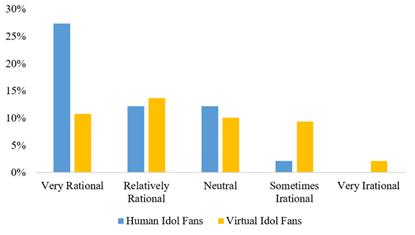
Figure 7: Self-Evaluation of the rationality of idol consumption.
One significant distinction between idol-related products and other regular products is that they often tend to be somewhat overpriced due to factors such as limited editions and price manipulation by scalpers. Additionally, the willingness to purchase premium idol products varies between the two fan groups (Figure 8). Approximately 65% of virtual idol fans express a willingness to purchase premium products, and they are generally accepting of a premium ratio of around 37% (weighted mean). On the other hand, only half of the human idol fans are open to purchasing premium idol products, with a weighted mean premium ratio of around 16%. This further highlights the tendency for irrationality and higher purchasing power among virtual idol fans.
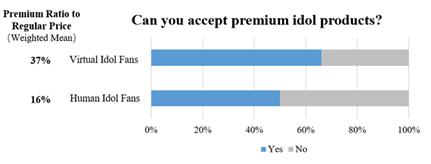
Figure 8: Comparison of the willingness to purchase premium idol products.
Fans of both virtual and human idols demonstrate a willingness to invest both time and money in their idol-related interests, with an average monthly expenditure of approximately 1,519 RMB in total (Figure 9). The monthly average income (RMB) shows a relatively small difference between the two groups, with human idol fans averaging 5,200 RMB and virtual idol fans averaging 4,922 RMB. However, there is a significant disparity in terms of purchase amounts. Virtual idol fans have a mean monthly purchase value of 2,459 RMB, whereas their counterparts spend only 717 RMB on average. Furthermore, when it comes to the proportion of fans who have spent over 20% of their income on purchasing idol-related products, the ratio is 56% among virtual idol fans and 21% among human idol fans. This highlights a substantial difference in purchasing behavior and a higher willingness to allocate a significant portion of their income toward idol-related products.

Figure 9: Monthly purchase and monthly income bubble chart of two fan groups.
3.6.Different Marketing Strategies to Target These Two Groups
Data analysis reveals some variations in consumption behavior between the two fan groups, providing valuable insights for targeted marketing strategies. The algorithmic content production on the TikTok platform plays a crucial role in ensuring precise content delivery to the intended audience, thereby increasing the effectiveness of reaching fans and capturing their interest. The research team explores the types of content that can stimulate respondents to engage in consumption and discovers distinct preferences. Fans of human idols show a higher interest in purchasing the same products as their idols and participating in their idol’s live broadcasts (Figure 10). On the other hand, fans of virtual idols are more inclined to share product recommendations and engage in offline activities with fellow fans. Endorsement or joint promotion videos featuring idols can also effectively stimulate consumption among virtual idol fans. These insights highlight the importance of tailoring marketing approaches to the specific interests and behaviors of each fan group, recognizing the divergent motivations and preferences between fans of human idols and fans of virtual idols.
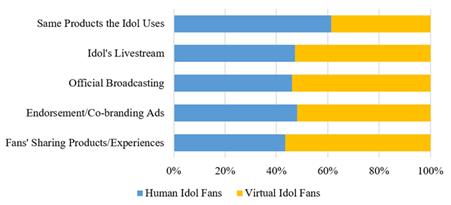
Figure 10: The contents to stimulate fans purchase of idol-related products.
The main reason some users never consume is that they prefer to spend their money on more meaningful things. A potential marketing strategy could be to emphasize how idol peripherals or related products can add value to their lives. For example, highlighting how owning a limited-edition idol peripheral can bring a sense of uniqueness and exclusivity to their collection or how attending an idol concert can create a memorable experience that they will always cherish. The second reason why users never consume is due to a lack of income and idol consumption being more rational. A potential marketing strategy could be to offer more affordable options for idol-related products, such as merchandise that is priced lower or discounts for bulk purchases.
4.Discussion
While this paper provides valuable insights into the consumption behavior of human and virtual idol fans, some limitations should be considered. One of the main limitations of the paper is that the questionnaire survey relied on subjective responses from fans, which may not accurately reflect their actual behavior. Another area for improvement is that the team mainly conducts quantitative analysis rather than in-depth qualitative research on individuals with strong characteristics. In-depth interviews with specific samples demonstrating strong characteristics help better explore the reasons behind the observed consumption behavior. Additionally, some fans who like both types of idols may have reduced their consumption of each type due to budget constraints, which may have affected group analysis of their consumption behavior.
Despite these limitations, the paper highlights the unique characteristics of TikTok and the shift of virtual idol fans from niche platforms and communities like Bilibili to mainstream platforms like TikTok. One possible explanation is that TikTok can create the most engaging and in-depth content on the platform. By leveraging the algorithm recommendation of short videos, influencers, and idols can accurately target user groups with high fan stickiness and loyalty. The team members conclude that the findings can provide valuable insights for companies promoting idol-related products on social media platforms and contribute to a better understanding of the fan economy and its growth potential.
5.Conclusion
The analysis of the survey data allows this paper to draw key insights regarding user stickiness, identification with idol content, purchasing power, and the types of products purchased by fans of human and virtual idols on TikTok. These insights enable us to identify differences between the two groups and develop more effective marketing strategies while improving fan engagement on TikTok.
In conclusion, this paper provides valuable insights into the purchasing behavior, characteristics, and tendencies of Chinese Generation Z TikTok users who are fans of human and virtual idols. Through the data collection and analysis, this paper identifies the types of content that can stimulate fan consumption and purchasing behavior. By better understanding the differences between these two groups, the team proposes more effective marketing strategies that resonate with fans on TikTok.
Authors Contribution
All the authors contributed equally and their names were listed in alphabetical order.
References
[1]. Liang, Y., & Shen, W. (2016). Fan economy in the Chinese media and entertainment industry: How feedback from super fans can propel creative industries’ revenue. Global Media and China, 1(4), 331-349.
[2]. Qiao, L., & Yao, X. (2021). The Effect of Emotion on Consumer Behavior in the Fan Economy. Management Studies, 9(1), 50-54.
[3]. Ademolu, E. (2023). Understanding audience reception and interpretation of development communications: A research framework proposition. Journal of Philanthropy and Marketing, 28(1), e1769.
[4]. Li, Y., & Zhang, R. (2022, July). Research on the Consumers’ Purchasing Motivation and Strategies Based on the Fan Economy in Live Streaming. In 2022 2nd International Conference on Enterprise Management and Economic Development (ICEMED 2022) (pp. 104-112). Atlantis Press.
[5]. Kong, R., Qi, Z., & Zhao, S. (2021, December). Difference between Virtual Idols and Traditional Entertainment from Technical Perspectives. In 2021 3rd International Conference on Economic Management and Cultural Industry (ICEMCI 2021) (pp. 344-349). Atlantis Press.
[6]. Le, L. K. (2014). Examining the rise of Hatsune Miku: The first international virtual idol. The UCI Undergraduate Research Journal, 13(1), 1-12.
[7]. Kobayashi, H., & Taguchi, T. (2019). Virtual idol Hatsune Miku: Case study of new production/consumption phenomena generated by network effects in Japan’s online environment. Markets, Globalization & Development Review, 3(4).
[8]. Yang, J., Ren, J., Zhao, M., Chen, H., & Wang, H. (2023). The impact of value co-creation on consumer citizenship behavior: Based on consumer perspective. Frontiers in Psychology, 13, 1110011.
[9]. Anwar, S. M., & Hasbi, A. R. (2023). The effect of viral marketing, promotions and flash sales on the purchase intention online shopping z generation in marketplace tiktok shop. Enrichment: Journal of Management, 12(6), 4841-4848.
[10]. Haryanto, A. A. F., Komariah, K., & Danial, R. D. M. (2022). Social Media And Viral Marketing Analysis Of Purchase Decisions Through Tiktok Applications. Inovbiz: Jurnal Inovasi Bisnis, 9(2), 33-39.
[11]. Chiu, C. L., & Ho, H. C. (2023). Impact of celebrity, Micro-Celebrity, and virtual influencers on Chinese gen Z’s purchase intention through social media. SAGE Open, 13(1), 21582440231164034.
Cite this article
Huang,K.;Lin,Y.;Lou,X. (2023). Exploring Purchase Preferences of Chinese Gen Z Fans for Human and Virtual Idols on TikTok. Communications in Humanities Research,19,15-25.
Data availability
The datasets used and/or analyzed during the current study will be available from the authors upon reasonable request.
Disclaimer/Publisher's Note
The statements, opinions and data contained in all publications are solely those of the individual author(s) and contributor(s) and not of EWA Publishing and/or the editor(s). EWA Publishing and/or the editor(s) disclaim responsibility for any injury to people or property resulting from any ideas, methods, instructions or products referred to in the content.
About volume
Volume title: Proceedings of the 2nd International Conference on Interdisciplinary Humanities and Communication Studies
© 2024 by the author(s). Licensee EWA Publishing, Oxford, UK. This article is an open access article distributed under the terms and
conditions of the Creative Commons Attribution (CC BY) license. Authors who
publish this series agree to the following terms:
1. Authors retain copyright and grant the series right of first publication with the work simultaneously licensed under a Creative Commons
Attribution License that allows others to share the work with an acknowledgment of the work's authorship and initial publication in this
series.
2. Authors are able to enter into separate, additional contractual arrangements for the non-exclusive distribution of the series's published
version of the work (e.g., post it to an institutional repository or publish it in a book), with an acknowledgment of its initial
publication in this series.
3. Authors are permitted and encouraged to post their work online (e.g., in institutional repositories or on their website) prior to and
during the submission process, as it can lead to productive exchanges, as well as earlier and greater citation of published work (See
Open access policy for details).
References
[1]. Liang, Y., & Shen, W. (2016). Fan economy in the Chinese media and entertainment industry: How feedback from super fans can propel creative industries’ revenue. Global Media and China, 1(4), 331-349.
[2]. Qiao, L., & Yao, X. (2021). The Effect of Emotion on Consumer Behavior in the Fan Economy. Management Studies, 9(1), 50-54.
[3]. Ademolu, E. (2023). Understanding audience reception and interpretation of development communications: A research framework proposition. Journal of Philanthropy and Marketing, 28(1), e1769.
[4]. Li, Y., & Zhang, R. (2022, July). Research on the Consumers’ Purchasing Motivation and Strategies Based on the Fan Economy in Live Streaming. In 2022 2nd International Conference on Enterprise Management and Economic Development (ICEMED 2022) (pp. 104-112). Atlantis Press.
[5]. Kong, R., Qi, Z., & Zhao, S. (2021, December). Difference between Virtual Idols and Traditional Entertainment from Technical Perspectives. In 2021 3rd International Conference on Economic Management and Cultural Industry (ICEMCI 2021) (pp. 344-349). Atlantis Press.
[6]. Le, L. K. (2014). Examining the rise of Hatsune Miku: The first international virtual idol. The UCI Undergraduate Research Journal, 13(1), 1-12.
[7]. Kobayashi, H., & Taguchi, T. (2019). Virtual idol Hatsune Miku: Case study of new production/consumption phenomena generated by network effects in Japan’s online environment. Markets, Globalization & Development Review, 3(4).
[8]. Yang, J., Ren, J., Zhao, M., Chen, H., & Wang, H. (2023). The impact of value co-creation on consumer citizenship behavior: Based on consumer perspective. Frontiers in Psychology, 13, 1110011.
[9]. Anwar, S. M., & Hasbi, A. R. (2023). The effect of viral marketing, promotions and flash sales on the purchase intention online shopping z generation in marketplace tiktok shop. Enrichment: Journal of Management, 12(6), 4841-4848.
[10]. Haryanto, A. A. F., Komariah, K., & Danial, R. D. M. (2022). Social Media And Viral Marketing Analysis Of Purchase Decisions Through Tiktok Applications. Inovbiz: Jurnal Inovasi Bisnis, 9(2), 33-39.
[11]. Chiu, C. L., & Ho, H. C. (2023). Impact of celebrity, Micro-Celebrity, and virtual influencers on Chinese gen Z’s purchase intention through social media. SAGE Open, 13(1), 21582440231164034.





